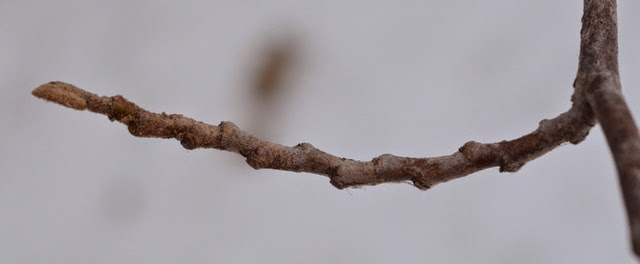 |
| Opposite apical buds on winged euonymous (Euonymous alatus) |
Dichotomous: Dikho (Greek: two, apart) + -tomia (Greek: cutting)
Given my familiarity with the gross anatomical features of twigs, I was ready to dive into identification by learning the specifics. It would be in my ability to discern variation in the different features that would allow me to use a dichotomous key and identify the twig of concern. A good dichotomous key is indeed a rare thing. Many field guides (most tree ID books) lack them because they often require highly technical language, making them difficult for neophytes (pun intended) to use. But they are incredibly useful as they force the observer to look and look again. Making good dichotomous keys (for anything) requires the following:
- Finding categories that you can use to lump the things you're studying into the largest groups possible. These categories will have to be binary. For humans, you might start with something like gender, or eye color. You wouldn't start with obscure characteristics, like has four fingers since this would give you two very uneven sized groups.
- Avoid relative characteristics (like big, frail, etc.) and be specific with numbers where possible
- Come up with characteristics that have only two answers. Essentially, you're creating two groups repeatedly until there's only one item in each group. So blond and not blond, male and not male
- Start with easy to observe characteristics. Things get harder to split into groups the more specific you get, so start with things that are simply and easily observed
- It relies on a characteristic not present on your specimen (mature bark deeply furrowed when you only have a sapling)
- It uses something clear to the author not clear to the user (e.g. too technical of language)
- Lack of clear contrast in characteristics (flowers red vs flowers pink)
- Uses relative or subjective characteristics (e.g. plants tall)
- One group is a clump of multiple characteristics (flowers yellow vs flowers white, red, or absent)
- The plant you have is not in the key! Plant ranges have changed over the years and an old manual may say your plant only grows south of Massachusetts.
Alternate
Each node - part of the stem where the buds originate/leaves attach (the internode, the space between two nodes, is nearly absent on spur branches) - only contains one lateral bud.
 |
| Opposite branching in white ash (Fraxinus americana) |
Opposite
Each node contains a pair of lateral buds.
.JPG) |
| Sub-opposite branching in glossy buckthorn (Frangula alnifolia), buds are paired, but not directly opposite one another |
Sub-opposite
Each node contains a pair of buds, though they are not directly opposite one another on the stem. This often will occur on rapid growth of plants that are typically opposite.
Whorled
Each node contains three or more buds. The least common branching pattern. We only have two species of hardwood trees/shrubs in Vermont with whorled branches. Catalpa and buttonbush.



No comments:
Post a Comment